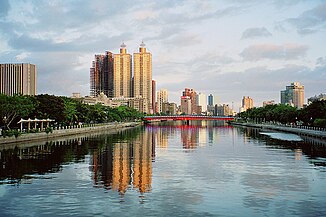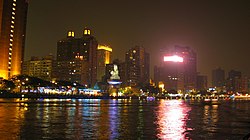Love flow
|
Love flow 愛河 Aìhé |
||
|
The Love River in downtown Kaohsiung |
||
| Data | ||
| location | Southwest Taiwan | |
| River system | Love flow | |
| source | Renwu District , Kaohsiung City | |
| muzzle |
Cross-strait , Kaohsiung Port Coordinates: 22 ° 37 ′ 25 " N , 120 ° 17 ′ 23" E 22 ° 37 ′ 25 " N , 120 ° 17 ′ 23" E
|
|
| length | 12 km | |
| Catchment area | 56 km² | |
| Big cities | Kaohsiung | |
The Love River (Chinese: 愛河 Aìhé; Taiwanese : Ài-hô) is a river in the area of the city of Kaohsiung in southwest Taiwan . It rises in the Renwu district , flows about twelve kilometers through the city center and flows as a border river between the Yancheng and Qianjin districts through the port of Kaohsiung into the Taiwan Strait . Despite its shortness, the Love River is one of the most famous rivers in Taiwan thanks to its tourist importance.
history
The name of the river was originally Takao River , after Takao , the name of the city of Kaohsiung at the time. It was used as a transport river for light ships and boats during the Qing Dynasty . During the Japanese rule of Taiwan , the city and river were renamed Kaohsiung in 1920 . The Japanese expanded the city's port and widened and deepened the river bed to facilitate the transport of goods to the port. This is how the river got its current shape.
Origin of today's name
According to various reports, the current name Liebes-Fluss is the result of structural change on the riverbank plus a number of coincidences. After Taiwan was handed over to the Republic of China by the Japanese in 1945 , parks were created on the banks of the river in which Kaohsiung residents could take a walk. Since such pleasant places were rare in the industrial city of Kaohsiung, the river soon attracted lovers for romantic walks. A resourceful businessman opened a boat rental company on the river called Aihe youchuan suo (愛河 游船 所, boat rental on the “love” river ). During a typhoon in 1948, the shop sign broke in two, only the part with the characters for love river remained. As luck would have it, an unhappy pair of lovers soon drowned themselves in the river. A newspaper reporter illustrated his account of the incident with a photo of the damaged shop sign that read Love River . It is difficult to decide which circumstances and coincidences contributed to what extent to the naming; What is certain, however, is that the - unofficial - name Liebes-Fluss became part of the everyday language of Kaohsiung's residents after the Second World War.
In 1968 the river was officially renamed 仁愛 Präsidenten ( Ren'aihe , river of goodness and love ) on the occasion of the 70th birthday of the first wife , Song Meiling , a name that did not catch on in the vernacular. In 1992 the river was officially christened the river of love by decision of the city council .
Change to a sight
After the Second World War, the Love River lost its importance as a transport route. Its water quality was soon affected by the advancing industrialization of Kaohsiung. Wastewater from heavy industry and private households was discharged unfiltered into the river, which thus became extremely polluted. Starting in 1977, the city gradually began to build sewers and clean up the river. Increasing environmental awareness and continued efforts made it possible to revive the dead river; today fish and jellyfish floating up from Kaohsiung harbor can be seen in it again.
tourism
With the improvement of the water quality and the continuous beautification of the banks with parks, the Love River became a popular destination for Kaohsiung citizens and foreign tourists. The waterfront promenades attract walkers and joggers, there are restaurants, cafes and street performers. Sometimes concerts are held on the river of love. Another attraction are river tours on small excursion boats known as “love boats”. Events on the occasion of traditional Chinese festivals also take place on the Love River:
Lantern Festival
The Lantern Festival , which traditionally takes place two weeks after the Chinese New Year , has been celebrated every year since 2008 on the banks of the Liebes River with a large lantern exhibition, fireworks and water features. Every year the event attracts real crowds from inside and outside Kaohsiung.
Dragon boat racing
Every year on the fifth day of the fifth month according to the Chinese calendar (in June according to the western calendar) dragon boat races take place on the river of love , in which schools, clubs, organizations, companies and privately organized teams zealously participate.
The Kaohsiung City Court, History Museum and Film Museum, and a hotel are located on the banks of the Love River. The Love River is highly symbolic for the residents of Kaohsiung, as it symbolizes the development of Kaohsiung from a purely industrial and port city to a modern metropolis with a high quality of life.
gallery
Individual evidence
- ↑ Kaohsiung City website on Love River ( Memento of the original from September 28, 2011 in the Internet Archive ) Info: The archive link was automatically inserted and not yet checked. Please check the original and archive link according to the instructions and then remove this notice.
- ↑ Kaohsiung City website on Love River ( Memento of the original from September 28, 2011 in the Internet Archive ) Info: The archive link was automatically inserted and not yet checked. Please check the original and archive link according to the instructions and then remove this notice.






